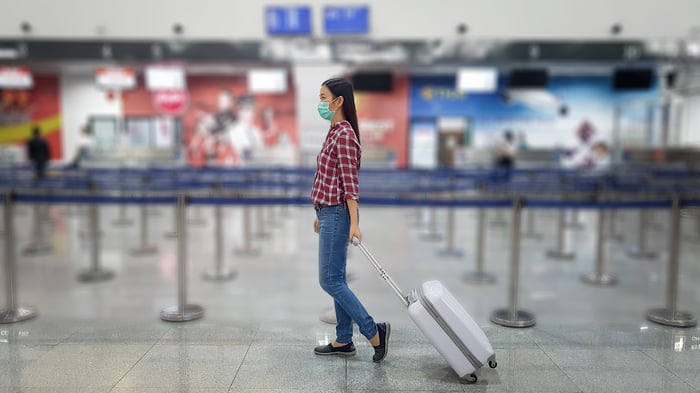The airlines secured the first tranche of their bailout late Tuesday, with a group of 10 public and privately held carriers agreeing to terms to receive some of the $25 billion in payroll support authorized under the $2 trillion Coronavirus Aid, Relief, and Economic Security Act (CARES Act).
The deals came after a week of negotiations over how the government would be compensated for its largesse, and includes the airlines issuing warrants totaling between 1% and 3% of their total equity. They also pledged to do no layoffs before Sept. 30, an important factor for the government, given the mounting jobless claims nationally.
"We welcome the news that a number of major airlines intend to participate in the Payroll Support Program," Treasury Secretary Steven T. Mnuchin said in a statement. "This is an important CARES Act program that will support American workers and help preserve the strategic importance of the airline industry while allowing for appropriate compensation to the taxpayers."

Image source: Getty Images.
The bailout provides additional runway to allow the industry to take off once the COVID-19 pandemic has subsided, and it eliminates the near-term bankruptcy risk. But does it make the sector attractive for investors?
What the airlines got
The airline sector has been among the hardest hit by the pandemic, which has caused travel demand to evaporate overnight. The industry has done what it can to cut costs, canceling tens of thousands of flights and grounding thousands of planes. But with revenue expected to fall by upward of 90% year over year, no amount of cutting is enough to stem the cash bleed.
Some airline stocks lost more than half their value in March, with investors fearing bankruptcies were inevitable. The industry came into the pandemic relatively healthy, but if nothing else, a significant number of layoffs and furloughs would have been required absent government assistance.
The amounts requested totaled more than the $25 billion allotted, meaning no carrier got enough to fully cover payroll. It appears airlines were granted funds to cover about three-quarters of their actual payroll in the second and third quarters of 2019.
"This is an essential step, but just one of many that will get us through the next several months," Delta CEO Ed Bastian said in a memo to employees. "The funding, along with self-help measures we have taken, will prevent furloughs and pay rate reductions through the end of September, despite the 95 percent drop we've seen in passenger traffic."
A sampling of what individual companies are getting:
- Delta Air Lines (DAL -0.06%) will receive $3.8 billion in direct support and a $1.6 billion loan.
- American Airlines Group (AAL 0.94%) will receive $4.1 billion in direct support and a $1.7 billion loan.
- Southwest Airlines (LUV 0.97%) will receive $3.2 billion in direct support and a $1 billion loan.
Other public companies receiving assistance include United Airlines Holdings (UAL 5.50%), Alaska Air Group (ALK 4.03%), Allegiant Travel (ALGT 0.83%), Hawaiian Holdings (HA -1.96%), and JetBlue Airways (JBLU 4.10%). The major noticeable absence from the list was Spirit Airlines (SAVE -1.95%), but a source said Tuesday night the airline was expected to agree to a relief package in the days to come.
Is it time to climb aboard?
For investors, it is important to understand what this bailout package is, and what it is not. The funding buys the industry time, in the hope that the pandemic will recede and travel patterns begin to normalize. But it only buys them a limited amount of time, and carriers including United have been blunt in saying that if traffic does not return by Sept. 30, there will be further cuts.
At best, it appears we are likely to emerge from the national shelter-in-place in a recession, and airlines in years past have not fared well during economic downturns.
I'm optimistic the airlines can survive without major liquidity issues, but pessimistic we'll see a quick recovery. While it is impossible to know what the future holds, investors should brace for a multiyear recovery and airlines needing at least two years (and perhaps longer) to return to pre-pandemic flying levels. For the next few years, expect to see smaller fleets and fewer employees.

Image source: Getty Images.
If so, it is safe to buy airline stocks, but best to focus on the best-run companies and those with competitive advantages. My picks right now would be Delta, Alaska, and Southwest, with Delta the most attractive of the three based on a balance of financial strength and how far the stock has fallen.
I'd avoid airlines like Hawaiian due to its niche network and reliance on higher-cost trans-Pacific flights, and JetBlue due to its strategy to attract premium travelers. Both are well-run companies that hopefully will be fine, but the risks are higher as you move down the spectrum. American and United can both match the scale advantages of Delta, but don't have the track record of success and don't trade at a sufficient discount to justify the added risk.
It's safe to board the airlines, but tread carefully, buckle up, and expect a long flight ahead.



